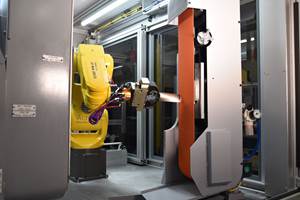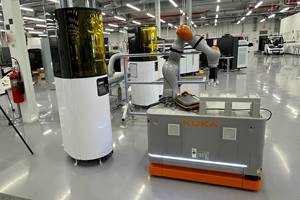Mosaic’s Array, Element 3D Printers for Digital, On-Demand Polymer Manufacturing
The Array system is able to print thousands of polymer parts on-site without operator intervention, which means lower lead times for manufacturers and customers, as well as more flexibility and resiliency in supply chains.
Share
Read Next
Two Mosaic Array units with 4 Element printers in each, with a robotic gantry system and storage carts. Photo Credit: Mosaic
Mosaic Manufacturing is taking steps to help bring 3D printing to the factory floor as it begins shipping Array and Element Products to North America. Mosaic is now shipping the first production Array products to customers in North America, followed shortly after by shipping its Element and Element HT 3D Printers beginning November 16.
The company says shipping Array technology marks a significant step in unlocking distributed, digital and on-demand manufacturing of polymer parts at scale. The Array system is able to print thousands of polymer parts on-site without operator intervention. This means shorter lead times for manufacturers and customers, as well as more flexibility and resiliency in supply chains. Mosaic says the Array technology will enable companies to reshore their polymer supply chains, upskill their teams and build next-generation manufacturing capacity to ensure they are ahead of the curve for years to come.
Made in Canada, Mosaic says Array is the first fully automated polymer 3D printing system available to the industrial market. Array’s patented automation technologies includes bed changeover, material automation, AI powered monitoring and software operation automation. Each Array includes 4 Element or Element HT 3D printers.
The Array is a high-volume print system designed to bring 3D printing to the manufacturing floor. Array features 4 Element or Element HT 3D printers, and is built with an integrated robotics system for automated bed changing, material handling and remote file management. By removing manual user touch points in the printing process, Array enables one operator to run the equivalent of approximately 250 3D printers. Array supports a wide variety of print materials, including ABS, CF Nylon, PETG, PEEK, PEKK, and PEI 9085.
The Element is an industrial-grade Fused Filament Fabrication (FFF) printer, enhanced with Mosaics multimaterial technology. Element is focused on creating high-quality parts, with a simple user interface and reliable operation. Element is able to support up to 8 materials in a single part and features a large and versatile 14 × 14 × 14" (355 × 355 × 355 mm) build volume.
The Element is available in a high-temperature model (Element HT) that features a heated chamber and a hot end that can withstand up to 500°C. The Element/HT also comes equipped with Mosaic’s reusable Material Pods, which track filament usage, type and monitor humidity and temperature inside the pod for Mosaic or third-party materials.
Each Element inside of Array comes equipped with a large build volume, and individually temperature-controlled chambers. This means users can print high-temperature materials on one Element and, in parallel, low-temperature materials on another. Each Element 3D printer comes with the option of adding a heated chamber and high-temperature hot end in order to print PEEK, PEKK and PEI materials. This heated chamber also helps produce stronger parts printed in ABS, Nylon and PC.
Mosaic’s Canvas software platform acts as the user’s control center for Array. Canvas enables users to slice parts, manage print queues and keep track of completed builds. Users can collaborate with Canvas teams to share files and run prints for team members. Canvas Edu (Education) enables educational institutions to manage thousands of student submissions in a simple and automated manner.
The first production units of Array and Element are being shipped after a six-month customer pilot program was completed in order to ensure product stability and reliability. This pilot included the shipping of 4 Array units, and more than 40 Element/HT printers. These pilots were completed across companies in the manufacturing, education and health care industries. In order to document their experiences, Mosaic is releasing 3 case studies on how these pilot organizations adopted Array and Element in their workflows — Avid Case Study; PolyUnity Case Study; and IDeATe Lab.
Mosaic developed Array as a solution to overcome the scaling issues associated with traditional print farms. Mosaic’s multimaterial technology has been used for almost a decade to support print farms around the world. Working closely with industry leaders, the company says it was clear that the lack of automation and purpose-built solutions meant for production were leading to significant amounts of labor to operate and maintain farms of individual printers. Scaling with traditional 3D printers did not work for these customers, and costs were much higher than anticipated. Array is designed to set a new standard for the lowest and most predictable production costs at scale with a plug-n-play production platform.
- Learn more about the Mosaic Array — automated print farm with machine tending and more. Mosaic’s Array additive manufacturing system combines multiple forms of automation, including machine tending, material management and scheduling, to enable unattended production.
- Listen to this episode of AM Radio to hear a report from RAPID + TCT 2022 which includes discussion of the Mosaic Array in action near the end of the episode.
Related Content
3D Printed End of Arm Tooling Aids Automation
Frustrations with traditional end of arm tooling led Richard Savage to start 3D printing custom versions for injection molding applications, eventually founding a company to fill this niche.
Read MoreUnderstanding HP's Metal Jet: Beyond Part Geometry, Now It's About Modularity, Automation and Scale
Since introducing its metal binder jetting platform at IMTS in 2018, HP has made significant strides to commercialize the technology as a serial production solution. We got an early preview of the just-announced Metal Jet S100.
Read MoreAircraft Engine MRO: How Additive Manufacturing Plus Robotic Finishing Will Expand Capacity for Blade Repair
AM offers the chance to bring fast, automated processing to individualized, part-by-part restoration of turbomachinery. A cell developed by Acme Manufacturing and Optomec is able to automatically repair 85,000 unique aircraft engine blades per year.
Read MoreAutonomous Cobot Automation Increases Production 3D Printer Output for Ford (Includes Video)
A mobile robot that travels to each Carbon machine to unload builds lets the automaker run an additional three to four builds per machine per day. Autonomous robots fit well with 3D printing, but their role in production will extend beyond just the additive machines.
Read MoreRead Next
Hybrid Additive Manufacturing Machine Tools Continue to Make Gains (Includes Video)
The hybrid machine tool is an idea that continues to advance. Two important developments of recent years expand the possibilities for this platform.
Read MoreAt General Atomics, Do Unmanned Aerial Systems Reveal the Future of Aircraft Manufacturing?
The maker of the Predator and SkyGuardian remote aircraft can implement additive manufacturing more rapidly and widely than the makers of other types of planes. The role of 3D printing in current and future UAS components hints at how far AM can go to save cost and time in aircraft production and design.
Read More4 Ways the Education and Training Challenge Is Different for Additive Manufacturing
The advance of additive manufacturing means we need more professionals educated in AM technology.
Read More

















